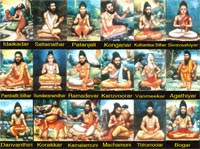We have already seen that, art of varma is basically a medical oriented art. Siththars told that, human body is composed of 72,000 interconnected naadis through which 10 types of air (vaayu) flowing are in order as follows:
Prana – Air of soul/life
Apana - Air of feces
Vyana – Air of actions
Udana – Air of sound
Samaan – Air of distribution
Naga – Air of conjuctiva
Kurma – Air of palpebra
Krikara – Air of sneezing
Devadatta – Air of yawning
Dhananjaya – Air of swelling
The junction point of these interconnected naadis is termed as knots of naadis and the air get stagnant in this place. We can infer by listening naadi. Agathiyar told the way of listening those naadis.
This knots of naadi is termed as varma point. We can alter the air/vaayu movement by touching or pressing these varma points and it is often termed as understanding of basics of varma. Any interested readers can refresh the idea of varma in the topic,
types of varma, where I have already discussed in previous posts.
In our modern medical treatment, we usually make patient either to unconscious state or inject him with certain medicine (anesthetic) to make him numb make them not to feel the pain. For this, there are specific medicines available nowadays. However in varma, by touching certain points, we can make the patient unconscious or feeling the numbness in specific body parts.
After the finishing of treatment, touching of certain other parts make them conscious again or make them to realize the senses in numb parts. This basic has been evolved as self defense art and becomes art of killing in later periods.
Apart from these, Agathiyar also discussed a way to control the excess bleeding due to accidental cutting using weapons or some other means as follows:
காயமது திருமேனிதனில்
kaayamathu thirumaenithanil
ஆயுதங்களின் அடவால் வெட்டுண்டு
aayuthangkalin adavaal vettundu
குருதியது வெளிப்போந்தாக்கால்
kurthiyathu velip poanthaakkaal
குருதியதை நிறுத்தும் உபாயமது
kurithiyathai niruththum upaayamathu
உத்தமனே உரைப்பேன் கேளு
uththamanae uraippaen kaaelu
கரமதின் கவளிகளது பிளவுண்டு
karamathin kavalikalathu pilavundu
குருதி கண்டால் மணிக்கட்டுதனில் பற்றிய
kuruthi kandaal manikkattuthanil patriya
மணி பந்த சூட்சுமமதில் பெருவிரலது
kani pantha sootchamamathil peruviralathu
கொண்டு அழுத்தி மனதினில்
kondu azuthththi manathinil
நூற்று எண்பது மாத்திரை அதை
nootru enpathu maaththirai athai
எண்ணி விரலகற்ற குருதியது
enni viralakatra kuruthiyathu
அடங்கும் அடங்கு மடாபரி தொன்று
adangum adangu madaapari thonru
அறிந்து கொள்ளடா மணிகட்டதுமுதல்
arinthu kolladaa manikattathumuthal
முண்டது காண் பகுதிதனில்
mundathu kaan pakuthithanil
வெட்டுண்டு இருதியது வருங்கால்
vettundu iruthiyathu varungaal
பதறாதே பய்ய வேமுண்டது உள்
patharaathae payya vaemundathu ul
வர்மநிலை தனில் ஆட்காட்டியதால்
varmanilai thanil aatkaattiyathaal
மாத்திரை அரை யூன்றியே பூரணமாய்
maaththirai aria yoondriyae pooranamaai
நூற்று இருபத்து எண்ணியே விரலகற்ற
nootru irupaththu enniyae viralakatra
குருதியது தானெனவே நிற்கும்பாரு
kuruthiyathu thaanaenavae nirkumpaaru
பாரெனவே சிரசதனில் குருதியது
paarenavae sirasathanil kuruthiyathu
பெருக்கம் கண்டால் சென்னிபற்றிய
perukkam kandaal sennipatriya
செவிக்குத்தி கால மதில் ஆட்காட்டியதில்
sevikkuththi kaala mathil aatkaattiyathil
மாத்திரையது காலளவு வழுத்தி
maaththiraiyathu kaalalavu vazuthhti
அகவினில் எண்ணமது இரு நூற்று
akavinil ennamathu iru nootru
நாற்பது தாமதித்து விரலகற்றிட
naarpathu thaamathithtu viralaktrida
சுகம்தானே சுகமாய்தானே
sukamthaanae sukamaaithaanae
மற்றொன்று கேளாய் மகனே
matronru kaelaai makanae
அதரமது அருகில் தானடா சுழிவர்மம்
atharamathu arukil thaanadaa suzhivarmam
சுண்டு அன்னம் முகவாய் தனில்
sundu annam mukavaai thanil
குருதி காண் சுழியதில் விரலுன்றி
kuruthi kaan suzhiyathil viralundri
மாத்திரையது கால் வரையறுத்து
maathirayathu kaal varaiyaruththu
உள்மனதினில் அறுபது எண்ணமிட
ulmanathinil arupathu ennamida
குருதியது சேதமிடல் தட்டென
kurithiyathu saethamidal thattena
நிற்கு மடா ஊட்டமான ஊட்டியதனில்
nirku madaa oottamaana ootiyathanil
வெட்டுண்டு குருதியது கொட்டுங்கால்
vettundu kurithiyathu kottungaal
குறியானது குரல் முடக்கியதில்
kuriyaanathu kural mudakkiyathil
விரல்களது ஊன்றியே பாங்காய்
viralkalathu oondriyae paangaai
பரிவுடனே மாத்திரையது அரைதான்
parivudanae maaththiraiyathu araithaan
வழுத்தி நவமணி முறை பூஜ்யமதில்
vazuththi navamani murai poojyamathil
எண்ணிட இரத்த மது சுகமாய் நிற்ககுமடா
ennida iraththa mathu sukamaai nirkakumadaa
கரமது வெட்டுண்டு இரத்தப்
karamathu vettundu iraththap
போக்கால் அவதி கண்டால்
poakaaal avathi kandaal
மற்றொரு உபாயமது கூறுவேன்
matroru upaayamathu kooruvaen
கேளாய் மகனே கம்கூட்டது
kaelaai makanae kamkoottathu
சேருமிட சேர்க்கையதில் விரலூன்றி
saerumida saerkkaiyathil viraloonri
சுகமாய் அழுத்திட உதிரப்போக்கது
sukamaai azuththida uthirappoakkathu
தீரும்பாரு திடமான கால்களதில்
theerumpaaru thidamaana kaalkalathil
ஊனது தோன்றி குருதியது நீர் போன்று
oonatha thonri kuruthiyathu neer ponru
வெளியேறி னாக்கால் தயவான
veliyaeri naakkaal thayavaana
நெறி வர்மமது இருபுறமும் பற்றிட
neri varmamathu irupuramum patrida
குருதியது தானென நிற்கும் பாரு
kuruthiyathu thaanaena nirkkum paaru
நின்றெனவே முழங்காலதின்
ninrenavae muzhangaalathin
கீழ்தானடா ஆயுதமதால் தாக்கமது
keezhthaanadaa aayuthamaathal thaakamathu
கண்டால் நடுத்தொடை சூட்சுமத்தில்
kandaal naduththodai sootchamaththil
திறனாய் அழுத்திட குருதியது
thiranaai azhuththida kuruthiyathu
நிற்கும் பாரு பாரெனவே இரத்தப்
nirkkum paaru paarenavae iraththap
பெருக்கத்தை நிறுத்த இறுதியான
perukkaththai niruththa iruthiyaana
வர்மசூட்சுமம் இது தானடா மைந்தா
varmasootchumam ithu thaanadaa mainthaa
பாதமது இணையும் காலது பொருத்துதனில்
paathamathu inaiyum kaalathu poruththuthanil
பற்றிய வர்மமதில் பெருவிரலால்
patriya varmamathil peruviralaal
தட்டெனவே அழுத்திட குருதியது
thattenavae azhuththida kuruthiyathu
சீரென சினராமல் நிற்குமடா
seerena sinaraamal nirkumadaa
- அகத்தியர் (Agathiyar)
I have stopped the bleeding of two persons who met with an accident, using varmam technique. According to me, varmam is a obviously a splendid art in these type of emergency situation.
Apart from these, Agathiyar describes the use of this art to figure out the hints of some other diseases and its cure in his book. If time permits, I will share those things in future with gracious blessings from my guru.
As of now, one interesting topic is in balance to share. Of course! It is noakku varmam. What is noakku varmam? Is this art still in use? What can we do with this noakku varmam? What can be done?
I will see you in upcoming post with answers for above question.
Stay tuned!!
Translated by Lalilthambika Rajasekaran


